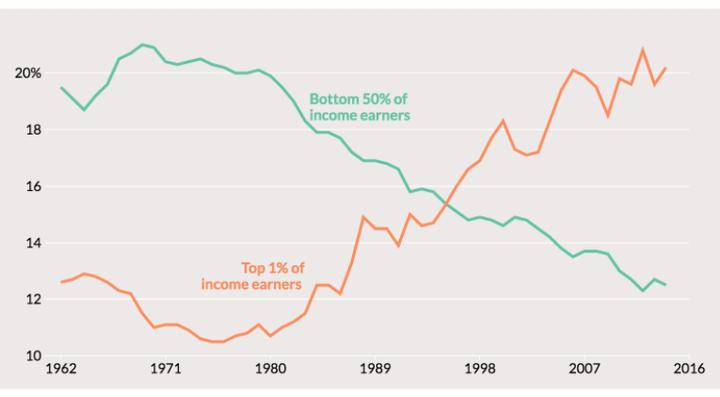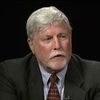
A Tale of Two Countries: The share of pre-tax income for the bottom 50% of income earners in the U.S. compared to the top 1% of earners from 1962 to 2014. The unit used in the graph is the incomes of individual adults and married couples split evenly in thousands of 2014 dollars.
As Congress takes up tax code reform, there is one thing we can be sure of. Most of us will not understand what the House and Senate are doing. The political dynamics and complexity of changing the 30-year-old code will make health care reform look simple.
We’ve heard the numbers. At around 75,000 pages and 2.4 million words, the tax code is twice the size of Encyclopedia Britannica and nearly 200 times longer than it was a century ago. According to the latest report from our National Taxpayer Advocate at the IRS, it takes individuals and businesses 6 billion hours every year to prepare and file their taxes.
Congress will have the opportunity, but not necessarily the political will, to clean up the code by trimming away loopholes, unnecessary subsidies and obsolete provisions. We have entered a new century, a new economy, and a new set of urgent national priorities since the last comprehensive reform.
If Congress makes its deliberations transparent, as it should, we will see a debate whose subject matter is more opaque than advanced calculus. So how will we know that the code doesn’t turn out to be another bundle of privileges for the privileged, designed to keep the same winners and losers in the economy?
One approach is to identify the high-level goals we want tax reform to accomplish and to stay alert to whether Congress is addressing them. Closing the debilitating gaps in the economy should be at the top of the list. They include the opportunity gap, the income gap, the wealth gap and the skills gap.
The Income Gap: Since the1970s, income inequality has grown in every state. Analysts are still citing a 2013 report from the Economic Policy Institute that the average annual income of the top 1% in the United States is $1.15 million, 25.3 times more than the income of the 99%. Between 2009 and 2013, the top 1% of earners captured more than 85% of income growth. GDP doubled over the last 30 years, but median household income grew only 16%.
This year, the jobless rate has fallen but average Americans find that their wages are not keeping up. Analysts say the slow growth in national average wages is partly the result of highly paid Baby Boomers retiring and being replaced by lower-paid younger workers. The bottom line, however, is that the United States has the third highest level of income inequality among developed nations.
The Wealth Gap: Many analysts consider the wealth gap to be more important than the income gap. Wealth is defined as a person’s or family’s total assets minus their debt and other liabilities. Wealth assets include things like home ownership, investments, retirement accounts and cash savings.
Forbes reports that in 2015, the 400 richest Americans held as much wealth as 16 million African American households and 5 million Latino households.
The income and wealth gaps are especially pronounced between urban and rural populations, a pattern known as “spatial inequality”. “Our country isn’t just divided by politics or class, it’s divided by where you live,” according to University of Toronto Prof. Richard Florida. “The advantaged urban parts of the country by the coast…they’re the blue areas, but the rest of America is increasingly red.”
The backlash motivated by the wealth gap between urban and rural populations is widely cited as a significant factor in the election of Donald Trump.
The Skills Gap: The skills gap results from rapid changes in the economy combined with a lack of applicable worker training. Industries, technologies and consumer preferences are evolving so quickly that the labor force cannot keep up. Even if good jobs are available, there may not be enough skilled workers to fill them.
In the 1970s, nearly 20 million Americans worked in manufacturing, 22% of the workforce. While there has been an uptick recently, only 12.4 million Americans, or 8% of the workforce, have jobs in manufacturing now. The anomaly is that although manufacturing jobs have declined, manufacturing output in the United States is at an all-time high. One reason is that robots are replacing human workers.
New ways to extract low-cost natural gas are leaving coal miners without work. Renewable energy technologies that were not competitive a few years ago are creating jobs 12 to 17 times faster than the rest of the economy today. Self-driving vehicles will leave truck, taxi and delivery drivers jobless. We can expect auto-making to shift increasingly to electric vehicles, requiring new skills and changing the demand for petroleum.
In other words, new and better technologies may improve our lives, but they are disruptive. Workers may find that they have to change their skill sets several times during their careers. The nation’s policies, and perhaps the tax code, should support life-long education.
The Investment Gap: Much of the capital spent by domestic businesses today, 80%, is used to replace old capital stock – for example, obsolete or worn out equipment. Only 20% goes to new investments. A similar imbalance is found in the nation’s infrastructure investments. Economist Timothy Taylor says this is a problem because it may lead to a slow-growth future for the United States.
Another troublesome fact is that 500 of the biggest corporations based in the United States have parked $2.6 trillion offshore to avoid the taxes they would have to pay if they repatriated their foreign profits. That capital is more than enough to repair and modernize the nation’s aging and failing infrastructure while creating many new jobs over the next 10 years, according to the American Society of Civil Engineers (ASCE).
If we do not make that investment, the ASCE says, the U.S. economy will lose nearly $4 trillion in GDP and 2.5 million jobs by 2025. Deteriorating infrastructure will cost each U.S. household $3,400 yearly in disposable income, the ASCE says. Repatriated capital could be used for other investments, too, since several other sources of revenue help pay for infrastructure.
Right now, repatriated profits are taxed at 35%. Lobbyists and the Trump Administration are encouraging Congress to lower that rate. Congress should consider another option: No federal tax on the current stash of offshore profits when they are invested in critical job-creating national priorities. It is possible, if not likely, that the money put into stimulating the economy would result in greater benefits for the American people than money given to the government. The government would eventually benefit anyway from higher tax revenues resulting from the stimulus.
Future offshore profits could be taxed at a lower rate when they are repatriated, such as the 10 percent rate the Trump administration has proposed.
Congress should also consider motivating U.S. investors to liberate the $70 trillion in cash they have kept on the sidelines because of low investment returns. That’s nearly 10 times the $787 billion stimulus package Congress approved in the American Recovery and Reinvestment Act to help end the Great Recession.
If we close the income, wealth and skills gap, we will go a long way toward closing the opportunity gap that is keeping many Americans from reaching their full potential.
There are many more ways that tax code reform can help us capture the opportunities of the 21st century while ending problems caused by the current code. With the help of some friends in the investment business, I’ll offer a few additional suggestions in an upcoming post.
